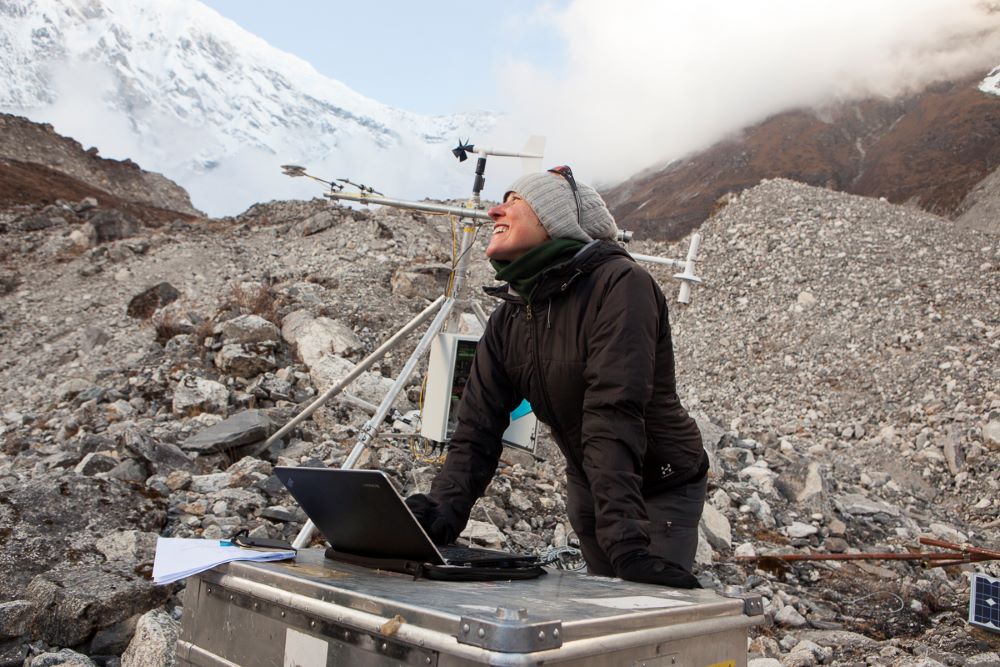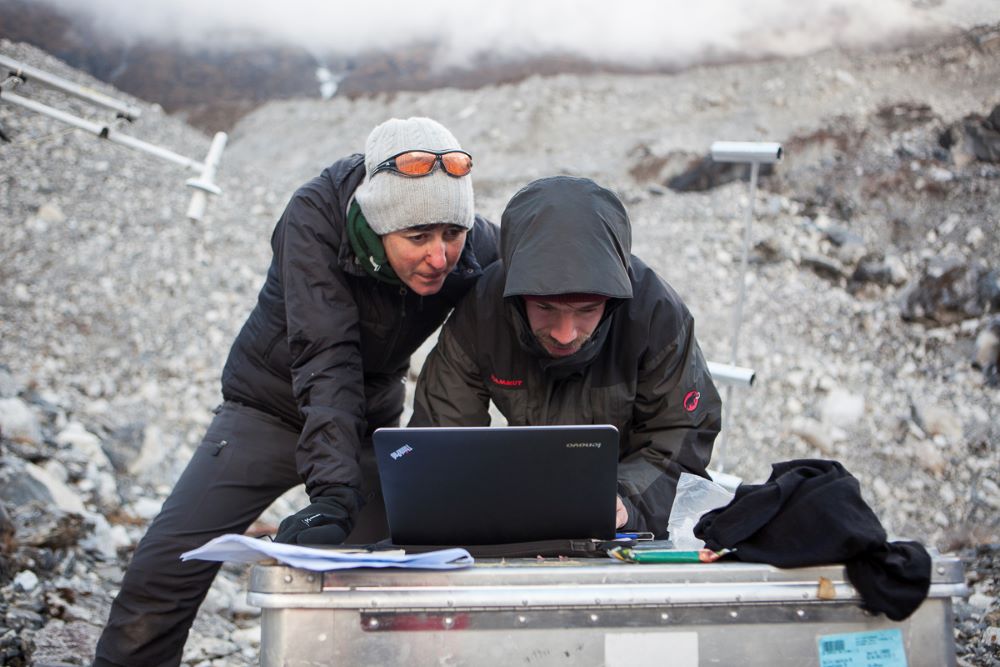October 25, 2023
Water Towers: The Glaciers and Climate Change
ISTA welcomes new Professor Francesca Pellicciotti
Francesca Pellicciotti’s love for mountains led her to gear her research toward glaciers, climate change, and water security. Using physical models, she simulates the interplay of a changing climate with glaciers, snow, and water supplies. Pellicciotti now joins the Institute of Science and Technology Austria (ISTA) as a full professor and receives funding from the EU Water4All Partnership to coordinate international research on megadroughts in Europe.

Pellicciotti’s passion for mountains has been a constant in her life. Growing up with a love for mountains and their people and a deep appreciation of nature, she fell in love with the idea of working in such an environment. Her fieldwork has allowed her to research globally, fostering a deep understanding of the current status of glaciers around the world. Pellicciotti uses mathematical models and data science to analyze data from field research and satellites.
The Last Growing Glaciers
Among the mountain ranges Pellicciotti is exploring are the Pamir and Karakoram mountains, where an anomalous state of glaciers led scientists to term the region and its glaciers the “Pamir-Karakoram anomaly.” This region of Central Asia, west of the Himalayas, is where hundreds of glaciers appear to be stable or growing, seemingly unaffected by global warming. “When I first saw glaciers there, I could hardly picture this: it’s the only place in the world where you can walk from the ground to the surface of the glacier without descending down a lateral moraine. The glaciers there are level with the surrounding terrain, a sign of their stable or growing state,” she says. To help understand this anomaly, the scientist works to encompass research in multiple areas.
There are challenges in working in such environments, but also great rewards. Being surrounded by and sharing your life for extended periods with fellow researchers, sharing tents and harsh conditions, and walking and hiking to great heights daily to reach camp are in Pellicciotti’s opinion the beauty of such work. “The bonding that comes as a result of the process is one that is precious, and lasting,” she says, “and I have had the privilege of working with a team of talented young scientists that share the same passion.”
Impacts of Global Heating
“We study the impact of climate change on the mountains and their water,” says Pellicciotti, who emphasizes the pressing need for climate action. “It is easy to forget that the north, south, and third poles–the Hindu Kush-Karakoram-Himalayan mountains–are not immune to our activities. Nor are we exempt from the effects that arise in these places. This is especially true in a world that is deeply interconnected.” Because of their necessity to travel far distances for research, maximizing the impact of their research and field trips is of utmost importance. Thus, Pellicciotti spends multiple weeks or even months at camps and only uses train travel within Europe. Limiting travel through prolonged and well-planned research trips allows scientists to ensure that their long-distance travel is meaningful.

Investigating Megadroughts
As Pellicciotti joins ISTA, she leads a collaborative project titled “MegaWat–Megadroughts in the Water Towers of Europe–From Process Understanding to Strategies for Management and Adaptation.” This project was now funded by the EU Water4All Partnership. Researching from ISTA, Pellicciotti will coordinate an international consortium of scientists from ETH Zurich, the Swiss Federal Institute for Forest, Snow and Landscape Research (WSL), Futurewater SL (Spain), Universiteit Utrecht (Netherlands), and Consiglio Nazionale delle Ricerche (Italy).
Megadroughts are severe, persistent droughts that last for several years. They have occurred on every continent outside Antarctica in the last two millennia. Pellicciotti was inspired by the ongoing decade-long megadrought in Chile, which led to the declaration of a state of emergency, dramatic water scarcity, and crop failure. At the same time, the frequency of European droughts in the years 2015, 2018, and 2022 is unprecedented in more than 2,000 years. Europe might be facing a future of increasingly dramatic droughts, too, thus necessitating continent-wide research on the causes, risks, effects, and management strategies of megadroughts in Europe’s mountains, or “water towers.”
While shorter drought episodes–lasting less than a few years–show that glaciers act as buffers by supplying much-needed summer meltwater, little is known about the effect of decade-long megadroughts. Recent observations suggest that, after a number of drought years, systems reliant on glaciers might even experience increased water deficits. To address this knowledge gap, Pellicciotti and her team at ISTA will computationally simulate extreme European droughts of the past as well as the impact of future megadroughts on the European water towers. Their focus goes beyond the well-studied Alps to encompass some of the more marginal and neglected, geologically older mountains of Europe. Pellicciotti knows: “Older mountains such as the Carpathians and Pyrenees have felt the effects of climate change for longer. They have a story to tell us.”
Preparing for the Year of the Glaciers
With 2025 being the United Nations International Year of the Glaciers, the UN will be holding a large conference in Tajikistan. “This is a very exciting but also very important time for glacier research and its future implications,” says Pellicciotti. ISTA now hosts an expert committed to forging this research. “I am excited to join ISTA: it offers world-class research and facilities for my quite ambitious research, and I look forward to helping establish earth sciences here, and make ISTA a center of gravity and a pole of excellence for this research,” concludes Pellicciotti.
About Francesca Pellicciotti
Pellicciotti received her PhD in 2004 from ETH Zurich in Switzerland, where she worked as a postdoctoral researcher and senior scientist until she relocated to the UK in 2015 as an associate professor at Northumbria University in Newcastle. In 2018, she returned to Switzerland with an ERC Consolidator Grant to study the anomalous mass losses of High Mountain Asia’s glaciers and water resources as the group leader of the HIMAL (High Mountain Glaciers and Hydrology) group at the Swiss Federal Institute for Forest, Snow, and Landscape Research (ETH Domain).
Funding information:
Francesca Pellicciotti has recently received funding through the Water4All Partnership joint transnational call 2022 for the “MegaWat” project. The Pellicciotti group’s part of the collaborative project will be funded by the Austrian Science Fund (FWF).



